River crossings are the main challenge of Icelandic F-roads. If it wasn’t for them, 95% of F-roads would be easy to pass. However, they do exist and create a significant obstacle. Improper river crossings may cause huge and expensive damages to your car. In extreme situations, even your life may be at stake. That being said – prepare thoroughly for your river crossings! Here is a detailed guide on how to cross a river in Iceland.
With river crossings, it all comes down to HOW, WHERE and WITH WHAT.
By HOW I mean general rules for a safe river fording. It’s essential to adhere to them, no matter how big your car is.
By WHERE I mean where are you crossing. What is the type of river? How big is it? What is the season? How much did it rain recently?
By WITH WHAT I mean the type of vehicle you are operating. Generally said, the bigger the better – but it’s more complicated.
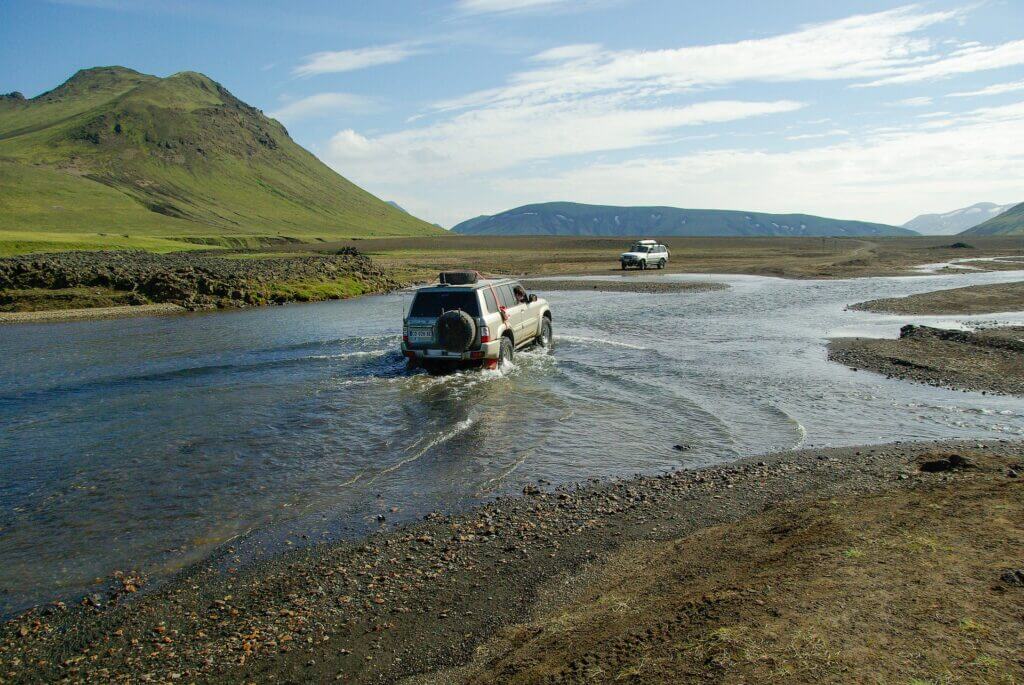
How to safely cross Icelandic rivers? (HOW)
- Make a plan. Do you have a proper car? What types of rivers are in your way? Are you equipped sufficiently? Think before.
- Check by searching for the road
- Check by searching for the place
- Check by searching for the area
- Check the road conditions. If they say impassable, don’t even try it yourself. Isak 4×4 can help you with their Convoy driver or sit-in guide. If they say passable, read further. What does it mean passable, impassable, and no winter service? Here is the explanation of Icelandic road states.
- Examine the river.
- So you arrived at the river. If you can see with your eyes that it’s a small river or even just a pond, you may usually proceed with passing. What’s a small river? Read below in “WHERE“.
- If you can’t assess the depth with your eyes, find out physically. Go into the river. How are you supposed to do that in ice-cold water? Get inspired by how we’ve done it.
- Alternatively, wait for someone else (ideally with a similar car) to pass.
- Compare the river to your car. The essential thing is, whether your air intake is high enough above the water level. But that’s not the only thing. See below in “WITH WHAT“.
- Stay inside yellow markers. Those mark the area allowed for crossing (and usually also shallowest). They are situated on the borders of a passable area.
- Go for the shallowest part.
- If it’s a medium-sized or even a bigger river, it’s really important to cross it through the shallowest part. This is usually NOT the exact middle of the river crossing, but rather its sides.
- This is usually NOT where the river is calm – that’s typically the deep part. Better find a part where you can see the stream of river running into pebbles and cross on that pebbles.
- Turn 4×4 mode on.
- Drive slowly.
- First, max second gear, around 10kph to create a little “wave” around your car. Ride that wave.
- If you drive too quickly, water will splash into your engine and your car may be dead. See below in “WITH WHAT“.
- Don’t stop. Don’t switch gears. If you do, you may not get the car going again. Don’t get scared by your car shaking inside the river, just go steady.
- Down the stream. If it’s possible, go with the stream, not against it. This will lower the chances the water will get into your engine.
- Stay near the rope. Sometimes there’s a rope in the river. It’s not there by coincidence. Rangers installed it there typically to indicate the shallowest part. Drive near the rope, this should be the best spot to cross the river.
Don’t want to fear paying for your drowned car? Use Lotus! Now with our 5% discount.
What types of river crossings are in Iceland? (WHERE)
The basic categorization can be made according to the depth of the river crossing.
- PONDS
- Up to 20cm / 8 inches.
- If the depth of a river crossing is this shallow, you don’t have to bother much about crossing at all. It’s doable with any car, even with a 2wd one.
- SMALL
- 20 to 40cm / 8-16 inches.
- Here some ground clearance of your car starts to make sense. I consider 40cm to be still a small river but it’s already a non-trivial crossing. If you do it wrong, you may end up like this.
- MEDIUM
- 40 to 70cm / 16 to 28 inches.
- This is already some decent river crossing. You will probably not get drowned but you may waste your car easily.
- It’s still a manageable crossing though, even for beginners! You just have to adhere to river crossing rules strictly and drive a proper car.
- Examples: F208 south, F235, F224, F910
- BIG
- More than 70cm / 28 inches.
- I would avoid these at all costs if I was a river crossing beginner. Not only may you waste your car, but you could also get yourself seriously injured, if not killed.
- You need to have a combination of a) proper car, b) adhering to river crossing rules, and c) experience
- Examples: F233, F249, sometimes F26, F88, F210
The depth of the river is the single most important factor when it comes to a river crossing. There are of course several other aspects influencing your fording:
- Has it rained heavily for a few days? Add some centimeters on top of your expected river depth.
- Is it just early summer? Glacial rivers will have substantially more water compared to the late summer.
- What is the riverbed like? Is it stony or muddy? If it’s muddy, it will be harder for you to ford.
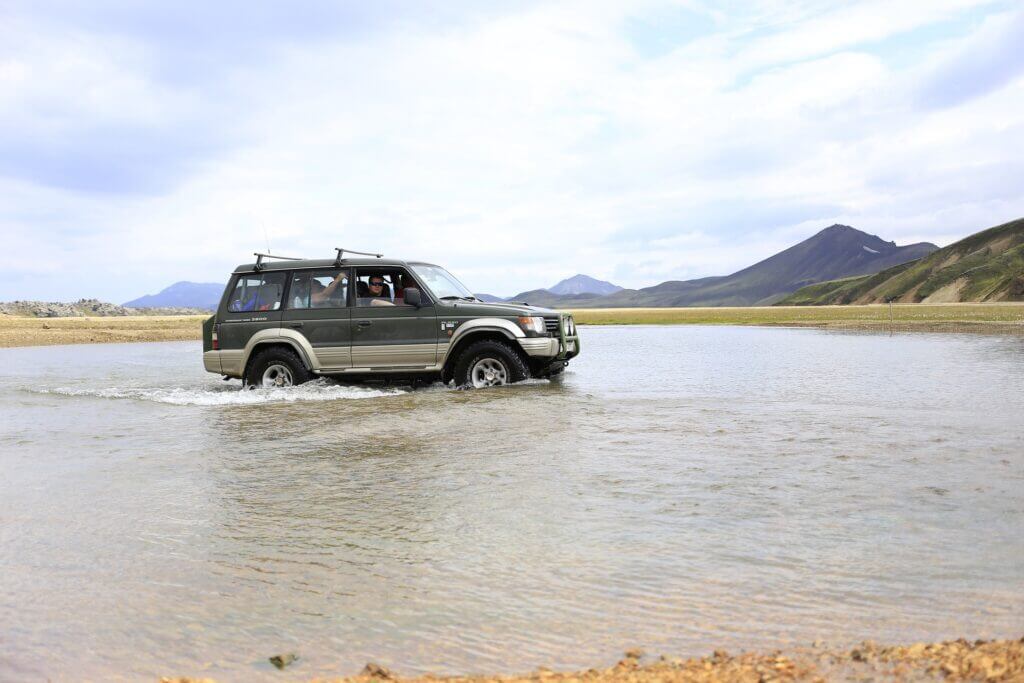
What car do I need to cross rivers? (WITH WHAT)
Ok now you know HOW to cross and WHERE will you be crossing. It’s time to get to WITH WHAT. A right car is essential. But how are you supposed to know what car is the right one? Of course, we are talking only about 4wd/4×4 now:
- The bigger the ground clearance (and wheels), the better. Because of several reasons. Firstly, your air intake will be higher (see below). Secondly, the chances you will get stuck in a river are lower. Thirdly, the chances, you will damage your undercarriage are lower.
- The higher the air intake, the better. Study this one carefully. The main risk with river crossings is flooding your engine with water (then the engine usually becomes dead). This happens once the water reaches an air intake of your car. The water level should be AT LEAST 10cm/4inch below your air intake!
- The stronger engine, the better. Inside rivers, some additional horsepower may only help. BUT – use your horsepower on the lowest/2nd lowest gear only when crossing the rivers!
- Snorkel is a plus. If your car has a snorkel installed, it basically deals with point number 2. It adds considerable height to your air intake. It’s not everything, though. You may have a snorkel, but with the too-low ground clearance, you could still get stuck in a bigger river.
When there are only PONDS in your way, you may basically choose any car.
When there are SMALL RIVERS in your way, ideally choose any SUV or 4wd car.
When there are already MEDIUM RIVERS in your way, choose your car wisely and better opt for at least a medium-sized SUV.
When there are BIG RIVERS in your way, either avoid them at all or if you really want to, then choose the super-jeep.
We also offer you FREE discount codes for several Icelandic car rental companies.
Example of the correct river crossing
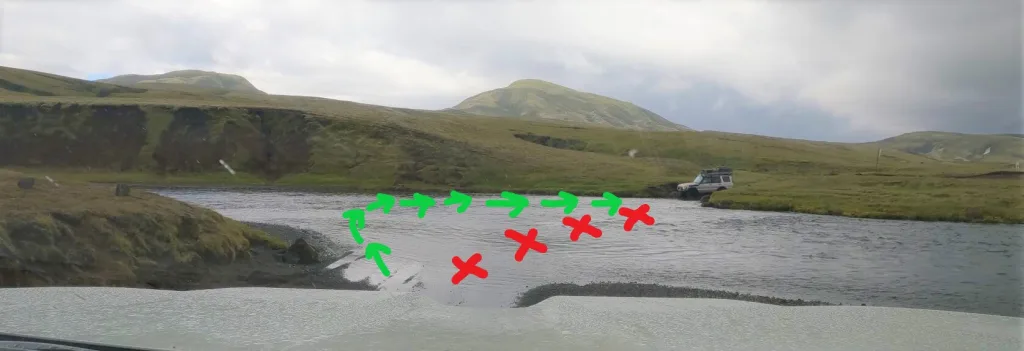
Correct river crossing of Sydri Ofaera river on F233
Every river crossing in Iceland is specific, and road F233 is a nice example of it. Syðri-Ófæra river crossing is the biggest obstacle of the notoriously known F-road Álftavatnskrókur or F233. Sydri Ofaera is typically a big river and also a very specific and unmarked river fording. The correct crossing is not obvious at first glance, but locals know it well.
The trick is, you should NOT ford straight. Rather, you have to drive in a U-shaped pattern. BUT – not to the east where the river is deep, but to the west, where it is shallow. OK, and why not go straight? Because there are huge boulders in the way that could easily stop even a super jeep.
Example of how NOT to cross the river
The video below from our friend Lucas is a nice example of how NOT to cross the river in Iceland. The driver has done nearly everything wrong:
- Drove through the deepest point (middle), instead of the shallowest parts (both sides where the ropes are)
- The river depth was too deep for Dacia Duster (in the middle), the car almost died and the driver was just lucky the engine started again.
- Blocked the road for another car, taking pictures and even being rude to them!
- Driving too fast through the second river crossing.
Below is a beautiful example of possibly the biggest mistake you should avoid when crossing rivers in Iceland. Never go fast! You will flood your engine this way. Exactly as the guy below flooded his engine. The car was dead within a second.



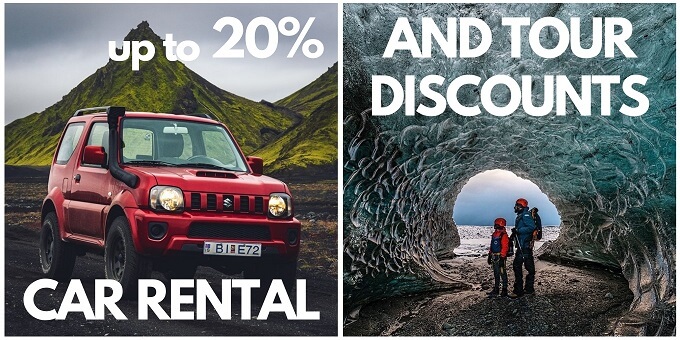
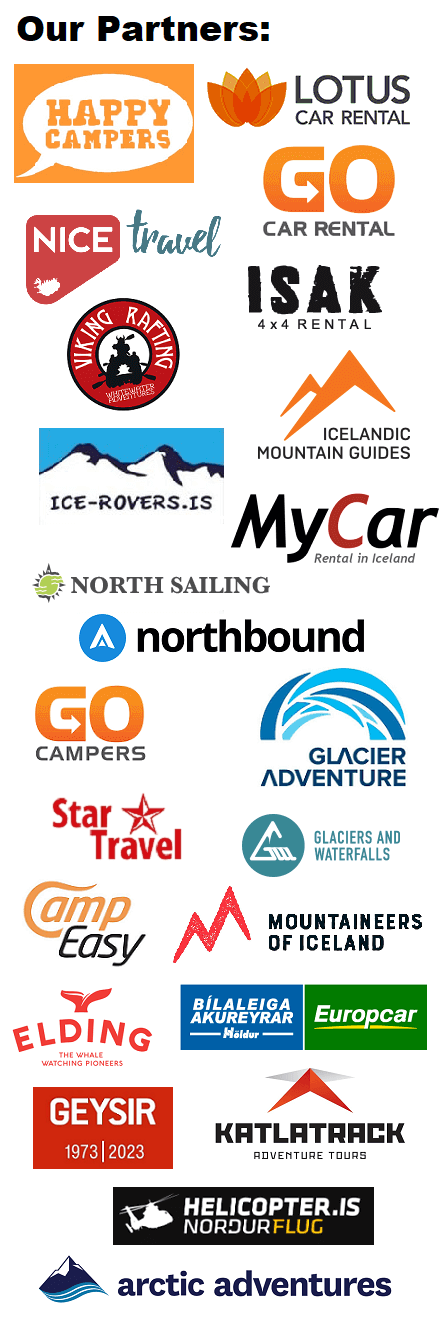

It’ll be my first time traveling to Iceland in early September and I cannot tell you what a help your site has been! I do plan on getting a 4×4 for small and medium river crossings, but wanted to ask your opinion about the road(s) leading to Thorsmork. From all I’ve read online so far it seems like you either have to rent a super-jeep or go with a guide (way too expensive)… is there any other way?? There are quite a few hikes there I wanted to check out so I would be staying overnight as close to the trailheads as possible. Thanks in advance for any advice!
Hi Galina, thank you very much for your words, they give us the energy to continue with the site 🙂
We wrote a detailed article about getting to Thorsmork here: https://epiciceland.net/detailed-guide-thorsmork-iceland/
Yes, you need at minimum a Land Cruiser to get there, sometimes even bigger car. But, you may still take the bus- and walk from Basar hut or Langidalur to all the hikes you want to do. You may also camp/rent an accommodation in this area. So you can definitely go on your own without guide and without car – by bus. It just takes more time and some planning.
Hello!
I really enjoyed your website, travelling and a detailed presentation of F-roads. I am living in Iceland and love to travel inside the country, although not Icelandic. I have done some of the described F-roads…but more to come. Regarding crossing the Sydri Ofaera river, I could suggest driving a bit further to west, more than you suggest in the picture and assure you the river bed is better. I was crossed with a friend the river, a guy who is born and raised in the area and very experienced with driving in highlands, including crossing rivers. I have first checked the river and then we decided to cross it. He followed pretty much what you suggested…still a bit bumpy cross while I was going a bit further to the west, on the little “beach” on your left side in the video before turning to east, in a U shape cross. I can tell you…my cross was smoother than his, with comparative cars. But of course, is always different so you better check on foot if not anyone is crossing in front of you.
Take care and keep up the great work!
Best regards,
Gabriel
Thank you Gabriel for your tip!
Thank you so much for useful information! My first trip ever to Iceland will be in June – will be on the island from June 8th until June 22nd with my 1200cc off-road MC. Riding alone. Hoping some of the “easier” F-roads will be open by then. I’m not too eager on river crossings, but hoping I will experience a couple that aren’t too hard to handle.
Kind regards,
Are
Thank you and Good luck with your trip!
Hi Igor
First of all, love your website. It is very helpfull and I enjoyed watching your video’s on YouTube.
This summer (end of July) me and my brother will be travelling to Iceland for the second time but this time we want to explore inland Iceland. We will be driving a VW Amarok (no snorkel). Do you consider this as a medium sized SUV?
Are there F-routes you discourage us to take? For instance we want to drive the F910 from Askja to F26 but I read it is a tricky one.
Thanks for your advise.
Hi Jorik and thank you!
VW Amarok can be mostly likely categorized as a medium-sized SUV so I would drive him on F-roads suitable for medium-sized 4×4 cars. For example F905/F910 to Askja form Egilsstadir, F208 south, F225, F347, F88, F946, F235, F206/207, F232 should all be fine with your VW if there are no floods in the rivers.
Central Highlands F910 is more suitable for bigger cars, Land Cruiser as a minimum. With some luck you may pass it without damage, but it’s risky. I would not recommend taking it, signs on the road recommend at least a 31″ car.
The same can be said about some harder F-roads like F210, F249 or F233, sometimes also F26 has a big river. There’s always a chance you can pass safely but I wouldn’t take a chance on these and simply consider them too risky.
Hello Igor,
First, thanks a lot for sharing the information, this is a great site, love it!
I’m planning the trip to Iceland in the middle of August and I want to drive roads F208 -> F26 with Dacia Duster.
Is it doable in your opinion?
Thanks in advance,
Alex.
Hi Alex, thank you!
Which parts exactly? The northern route to Landmannalaugar? Or the F26 across Iceland?
The northern route to Landmannalaugar is perfectly doable in Duster. The F26 across Iceland – I don’t recommend driving a Duster there. You may be able to pass Hagakvislar river on dry days, but you may not on wetter days.
Hi Igor,
Thank you for answering.
I thought about the second, F26 across Iceland.
I’ll take a chance, if weather will cooperate; if not, I’ll change the plan.
Thanks and best regards!
Hey Igor!
Thanks for this great website! I was looking to check out Landmannalaugar in a Mazda CX-5 in the next few days and was wondering how it would fare. I was hoping to drive in from the north on f208 and out to the south. It looks like getting in will be fine but I’m skeptical of f208 south. What are your thoughts?
Thanks so much,
Jake
Hi Jake and thank you!
I’ve seen cars like that pass fine during dry summer weeks (given they crossed the rivers correctly), but I wouldn’t do it after heavy rain.
You recalled me so many memories from my first trip in Iceland =)
I actually learned to ford thanks to some locals who let me join their convoy.
I was diying the first time but you guys are so cool and helped me to not be too scared (I had rented a suzuki Jimny).
My best trip ever.
Planning another trip but this time, fully on the road!
Great to hear that, enjoy your trip!
Hi Igor, We are plannin g to drive roads F905 and F261 on July with Dacia Duster 4WD. Do you think those are doable? Best wishes, Kai from Finland
Hi Kai, F905 should be OK (only if it’s very rainy it may not be OK).
With F261 – what is your plan? Just drive until the end and back? I don’t recommend crossing a river on F261 (Blafjallakvisl, eastern end of F261) with Dacia Duster. There’s a risk of drowning your engine.
Also, I don’t recommend driving a detour to Markarfljotsgljufur with Duster; it’s too rough and may damage the undercarriage and tires.
The other parts of F261 should be drive-able with Duster if you drive carefully, but generally, this road was not meant for medium SUVs like Duster, but rather for larger cars like Land Cruiser.
Igor,
I must say an impressive article and a must have for everyone who is traveling to Iceland especially more so considering traveling the F-roads which is the true essence of Iceland. We are planning on visiting Iceland on April 2nd-13th and we are renting a 4×4 Volkswagen Crafter from here(https://www.campervaniceland.com/4×4-camper). What should I be considering when crossing the rivers while I travel to Landmannalaugar and probably to Thórsmörk(only based on your advice)? Any help and tips for this type of vehicle especially for river crossings is greatly appreciated.
Thank you so very much again for your time and effort in putting this beautiful content together!
Hi Kaushik and thank you. All F-roads (including those to Landmannalaugar and Thorsmork) are closed in April. They only open on the break of June/July.
Also I would like to stress that campervans are NOT the vehicles for Thorsmork! There are dangerous river crossings on the way, and you should drive at minimum Land Cruiser, ideally a super jeep.
Some campervans can make it, but they need to be really adjusted to this (snorkel, modified tires, chassis, etc, like this one from http://www.gocampers.is, our readers have a 5% discount code: EPICICELAND on their vans).
You also need to adhere to all river crossing rules and have necessary experience with river crossings beforehand. Otherwise you may run into trouble. This is no joke, people have died crossing rivers with wrong vehicles in Iceland.
Igor, I read your page with many attention and I ask you an hint: next august I will be in Iceland and I would like to visit the west peninsula and the Askja’s area.
I will drive on the roads 60-65-88-905-910 and similar, a Ford Kuga 2000 4*4 is enough or not?
Thanks.
Paolo
Hi Paolo,
Ford Kuga 2000 4×4 is a city SUV, slightly less capable than Dacia Duster. I typically don’t recommend driving this car on F88, F910 or F905, you can damage the undercarriage or get it drowned in the rivers. It’s possible to pass with this car, but only under very good weather conditions (dry) and if you drive without mistakes. Also I would avoid F88, river there is unpredictable and can get bigger than those on F905 and F910. These two roads are mostly just very bumpy.
To sum up – if you are a good driver and do your research by asking locals onsite, at the time of your visit, you may give it a try on your own risk. I would rather rent a bigger car, though, to be sure to pass safely.
We also wrote a detailed article about getting to Askja and visiting Askja in general.
Hi Igor,
Your website is really very useful !
Do you think it would be possible to take the F232 at the beginning of August with a Suzuki Jimny? I especially think of Bláfjallafoss waterfall ?
Hi Marco and thank you!
Well, Jimny is a small 4wd car. This means, you can do it if weather and river is dry and if you drive well and cross the river well. Usually we advise for bigger vehicles, like Hilux or Land Cruiser to maximize the probability of passing safely.